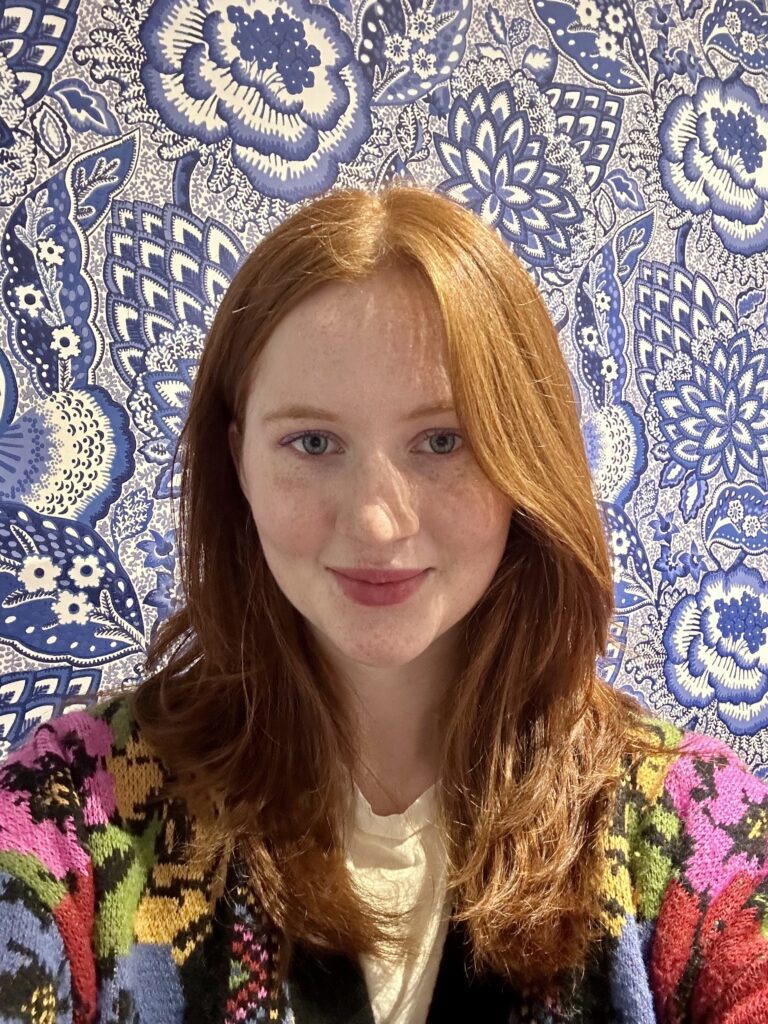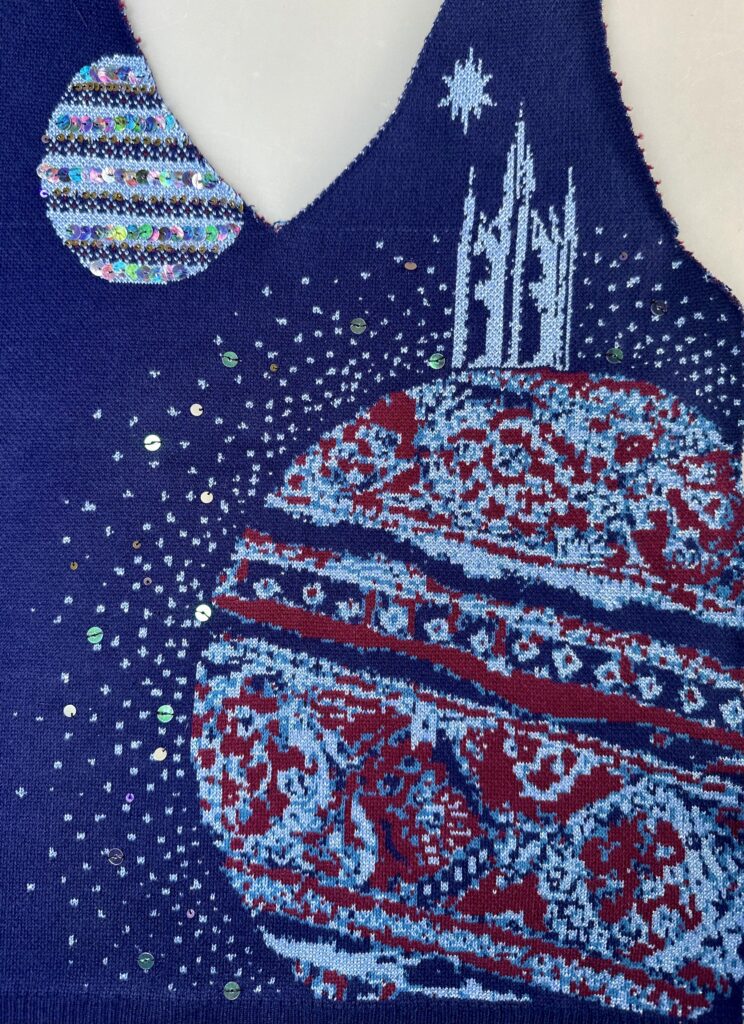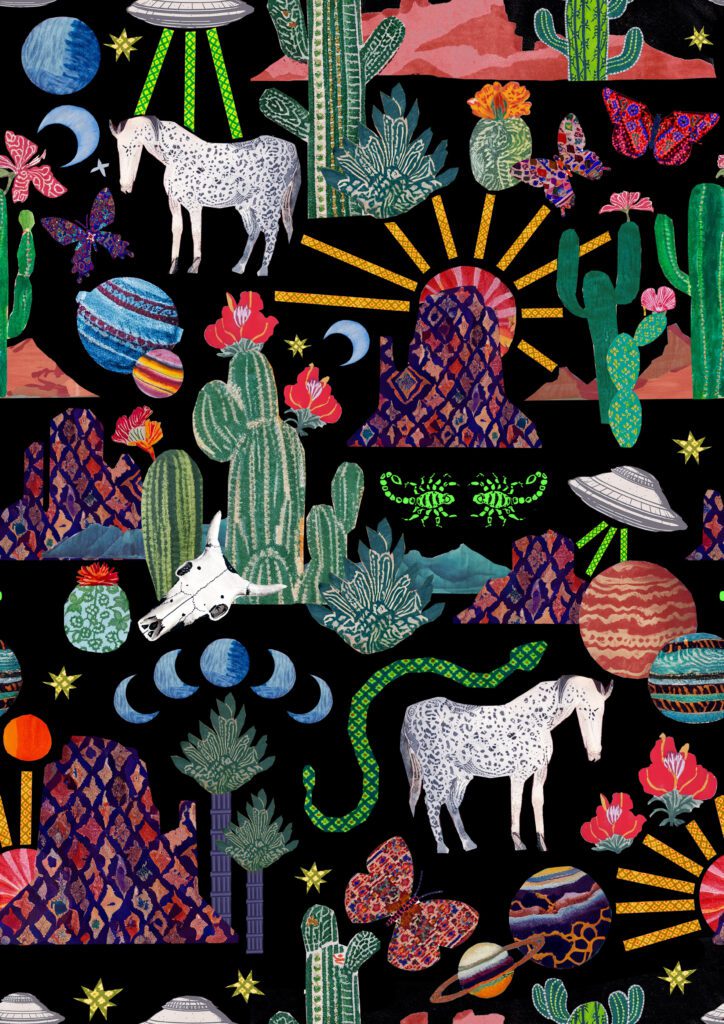
Embracing AI in Textile Design: A journey of creativity and collaboration
BA (Hons) Textile Design student, Megan Merhar, shares her journey of incorporating AI into her creative process.
She discusses how AI has transformed her approach to design, blending traditional techniques with new technology, and explores its potential to shape the future of art and design education.
About Megan
My name is Megan Merhar, and I am currently in my third year studying for a BA (Hons) in Textile Design, specialising in print and knit. As a designer, my work has always been deeply rooted in traditional techniques such as lino printing, painting, and ink drawing. However, my recent experience incorporating artificial intelligence (AI) into my practice has been transformational. In this blog, I’ll share how this journey unfolded, how I approached the integration of AI, and how I envision its role in the future of art and design education.

Discovering the opportunity
At the end of my second year, my Course Leader, Kate Farley, and the Director of Fashion and Textiles, Kevin Freeman, introduced our class to an exciting opportunity: a collaborative project involving Liberty London, Nottingham Trent University, and the University of the Arts London (Chelsea). The aim was to explore the potential of AI in design and create a toolkit to teach future students how to use AI responsibly and effectively.
Initially, I was apprehensive. My exposure to AI had been limited to the overly digital, airbrushed images often seen on social media—an aesthetic I wanted to avoid. However, I was intrigued by the challenge and the opportunity to work with Liberty London, whose design philosophy and iconic store have long been a source of inspiration for me. Over the summer, I began experimenting with Adobe Firefly, teaching myself how to communicate with the software. This process involved months of trial and error, but it gave me a deeper understanding of how to integrate AI into my creative process.
A collaborative day in London
Our first day of collaboration took place in London, beginning with a visit to Liberty London’s Oxford Street store. Alongside students from Norwich University of the Arts, Nottingham Trent University, and University of the Arts London, Chelsea (UAL), we attended a presentation that delved into Liberty’s design ethos, history, and archives. Seeing samples from different periods was especially inspiring.
Following this, we gathered at UAL Chelsea to explore the basics of AI. We were introduced to various tools, including MidJourney, ChatGPT, Adobe Firefly and New Arc. We participated in activities to understand their unique capabilities. For example, one exercise involved matching AI-generated images to the programs used to create them, helping us discern the distinct styles and outputs of each tool.
We also discussed the ethical implications of AI, particularly the distinction between generative AI, which creates original content, and models that rely on data scraped from existing works. This understanding was crucial as we sought to use AI in ways that aligned with both industry standards and our personal values.
Integrating AI into my practice
Building on this foundation, I developed a process that combined AI generation with my traditional techniques. Using prompts I had refined over the summer, I generated thousands of images, selecting elements to collage into repeat patterns. This approach allowed me to experiment with motifs, layouts, and colour palettes I might not have considered otherwise.
Once I finalised a pattern, I often extracted specific motifs to translate into knitted samples or garments. I was amazed at how seamlessly AI-generated designs could be integrated with Stoll knit software, resulting in dynamic and cohesive pieces. This process has reshaped my workflow, enabling me to focus on the aspects of design I’m most passionate about, while AI takes on some of the technical workload.

The impact on my design practice
This project has fundamentally transformed my creative approach. AI has shifted my role from being a sole creator to more of a composer, collaborating with technology to produce work that feels uniquely mine. Comparing this project to my previous work, I’ve noticed a stronger expression of my artistic voice, as the efficiencies provided by AI have allowed me to delve deeper into my concepts and themes.
Looking ahead, I believe AI will play a pivotal role in art and design education. By enabling students to produce work and refine their styles more quickly, AI has the potential to accelerate creative development. For instance, students can use AI to test ideas, gather inspiration, or focus on specific aspects of the design process they enjoy most.
“My journey into the world of AI has been one of discovery and growth. What began as a step outside my comfort zone has become an invaluable part of my practice, enriching my work and expanding my perspective. I am excited to see how AI continues to shape the creative industries and to be part of the dialogue about its potential in art and design education.”
Megan Merhar, BA (Hons) Textile Design student
Preparing for the future
To fully harness the potential of AI, both students and educators must adopt a mindset of exploration and adaptability. Practice is key; learning how to communicate effectively with AI tools—many of which rely on language-based inputs—can significantly impact the quality of results. Institutions can support this by providing dedicated time and resources for AI experimentation, as well as integrating AI communication skills into the curriculum.
While some may initially resist relinquishing aspects of creative control to AI, understanding its capabilities and limitations can lead to a more balanced and thoughtful integration. In textile design, areas such as repeat pattern generation, colour exploration, and motif development stand to benefit immensely from AI, offering new possibilities for innovation while preserving the human touch that defines our field.

Explore Our Courses

Textile Design BA (Hons)
Develop your professional skills and personal style as you prepare for a career in the textile industry on Norwich’s BA (Hons) Textile Design degree course
View CourseTextile Design BA (Hons)
Fashion BA (Hons)
Learn from fashion industry leaders and build a professional portfolio on Norwich’s BA (Hons) Fashion degree course.
View CourseFashion BA (Hons)
Fashion Marketing and Business BA (Hons)
Become a business strategist who understands the marketing mechanics behind big name and challenger brands on the catwalk and high street on Norwich’s BA (Hons) Fashion Marketing and Business degree course
View CourseFashion Marketing and Business BA (Hons)
Fashion Communication and Promotion BA (Hons)
Get set for a successful career in fashion marketing on Norwich’s BA (Hons) Fashion Communication and Promotion degree course.
View CourseFashion Communication and Promotion BA (Hons)News
@norwichuniarts
Norwich University of the Arts is proud to announce that it has been named the inaugural Arts University of the Year by the Daily Mail University Guide…
View this post

Norwich joins global conversation on creativity at ELIA Biennial 2024
Norwich University of the Arts’ Dean of Education, Professor Hilary Carlisle, recently took part in the ELIA Biennial Conference 2024 in Milan, held from 20 to 23 November.
View news article

Body Matters AHRA International Conference
Thursday 21 November – Saturday 23 November 2024
The 21st Architectural Humanities Research Association International Conference is taking place at Norwich this November, with the theme ‘Body Matters’.
View event

Embracing AI in Textile Design
BA (Hons) Textile Design student, Megan Merhar, shares her journey of incorporating AI into her creative process.
View blog
Post published: 13th January 2025